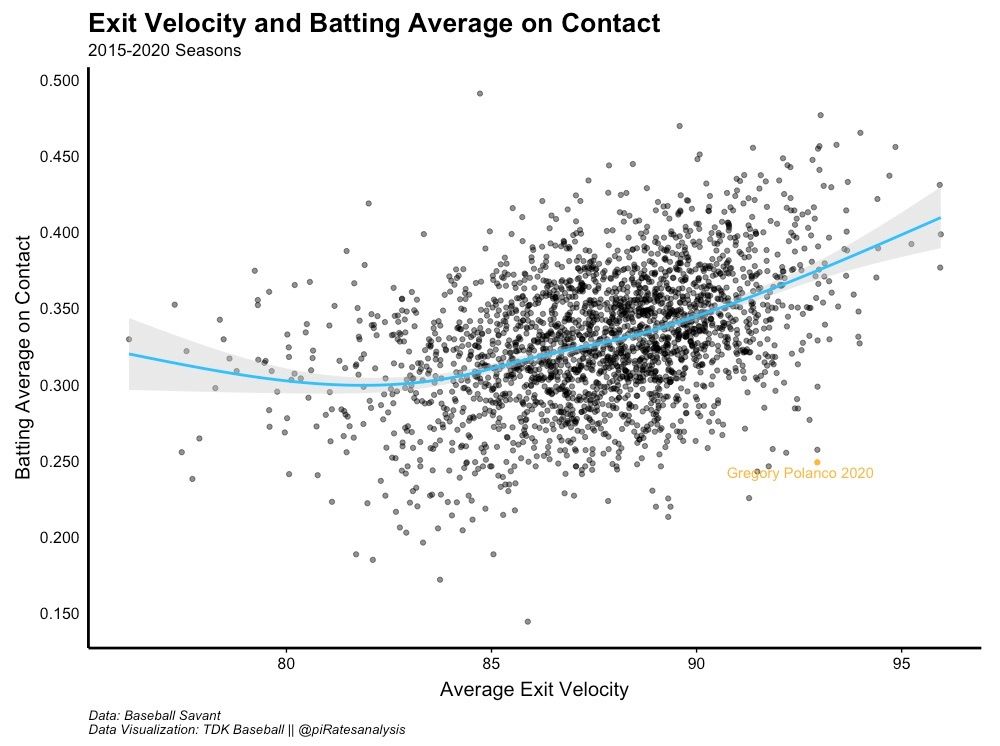BRADENTON, Fla. -- It was hard to tell who had the bigger smile, Gregory Polanco or the members of the Pirates’ bench. Polanco had just gone deep in the first spring training game of the year, and while it might have been aided a bit by the wind to clear the fence, it was a round-tripper nonetheless.
You know, just in case you needed a reminder that the raw power is still there, even after years of injuries.
Polanco has already been the subject of one Mound Visit in 2021, which focused on his sheer volume of whiffs and mechanics. I covered a lot of ground there, so I’d recommend giving that a read if you want a refresher on his 2020 season and the holes in his swing.
The short version is he didn’t look comfortable at the plate, and he came up empty far too often. He whiffed on 43% of his swings and struck out 37.4% of the time. Both were among the worst in baseball. His average exit velocity (92.9 mph) was in the top 5% of hitters league-wide, but that didn't matter as much since he failed to make contact so often.
That’s been the name of the game for the Polanco this offseason and heading into spring training: Just hitting the darn ball.
Mechanically, he has the same approach, though he is working on keeping his head through the zone longer so he can see the ball as long as he can. That homer Sunday was a product of that, as Polanco admitted he was a little late on the swing, but was still able to barrel it up.
“If you’re in the zone longer there’s just more surface level for contact, and that’s the goal,” Derek Shelton said.
But Polanco’s troubles aren’t limited to just making contact. Here’s the second problem he’s going to have to overcome:
That ball from Sept. 12 was tattooed at 111.5 mph at a 10 degree launch angle. By Baseball Savant’s measurements, that type of exit velo and angle yields an expected batting average of .840. But the infield was shifted perfectly, and it goes in the books as an L4.
This is a new challenge for Polanco. Teams have started to deploy shifts far more often the last few years, and Polanco faced a shift in 2020 over twice as often as he did in his last full season in 2018:

Courtesy of Baseball Savant.
Not only did Polanco face a shift in 86.8% of his plate appearances last year, they were extremely effective. When teams didn’t shift him, he had a .311 weighted on-base average (wOBA). That’s roughly league-average. When they did shift him, his wOBA dropped to .215, or about what a decent hitting pitcher would produce offensively.
Of the 67 players who had at least 100 at-bats in 2020 and were shifted at least 60% of the time, the only player with a lower wOBA on shifted at-bats was Rougned Odor (.201).
Don’t want wOBA? How about we look at just batting averages. Last year, of his 95 batted balls, 24 turned into hits. That’s a .253 average on contact, which includes balls in play and homers. Traditionally, the league has a roughly .300 batting average on balls that stay in the yard. Counting in homers, that average rises to about .328 on contact. Polanco’s .253 clip pales by comparison.
And once you compare that batting average on contact to Polanco’s exit velocities, you get a heck of an outlier of a season:

Data from Baseball Savant. Graphic courtesy of @piRatesanalysis.
Since the start of the Statcast era, no hitter made as hard of contact as Polanco did and had a lower batting average to show for it off those batted balls. That’s the power of shifts. It’s quite possible Polanco’s results would have gravitated towards the trendline over a full, 162-game season, but he was falling into the same pitfalls all year. Even if he did make more contact, it wasn’t going to yield much better results if he couldn’t spray the ball over the field.
Going back to that homer Sunday, it went out of left. Last year, Polanco only had three hits to the opposite field, and only one of them was barrelled up. On the swing Sunday, he got a sinker on the outside part of the plate and went with it.
That’s what he needs to do, and he recognizes that.
“With the shift right now, how they play me, I don’t have as much a chance to get on base every time I roll over to the right side,” Polanco said. “So I’m trying to put the ball in play all over the field. Obviously I’m not just thinking left field, because when I think too much of left field, my swing gets low... So I’m thinking through the middle right now.”
Yes, Polanco’s greatest obstacle is contact. No good ever came from a whiff. But he’s going to need to beat those shifts, too. A lower average exit velocity would probably be good news for him, if it means trading those 110 mph shots to the second baseman for 85 mph loopers the other way.
If he can do that enough to keep teams from shifting him almost every at-bat, then things might finally start to break his way.
Special thanks to @piRatesanalysis for his help scraping Baseball Savant and making the final graphic.

